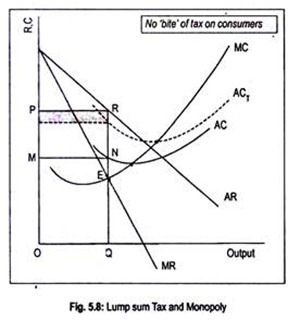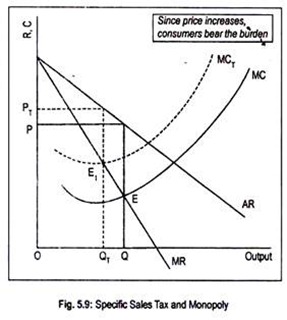Let us learn about the Effect of Taxes on Monopoly Equilibrium.
Lump Sum Tax and Profit Tax:
Imposition of lump sum tax and profit tax simply reduces excess profits of the monopolist since these two taxes are an addition to the total fixed cost. If the government imposes a 20% tax on profit of a monopolist then the fixed cost of the monopoly firm will go up since this type of tax is like a fixed cost. Same is true with respect to lump sum tax.
As fixed cost is independent of the level of output, imposition of such taxes will not alter MC of the monopolist. Hence the equilibrium in the monopoly market will remain the same and, consequently, output and price will remain unchanged. The only change that will occur is the reduction of profit of the monopolist. This has been shown in Fig. 5.8.
Equilibrium point is E where MC = MR. Corresponding monopoly output and price are OQ and OP, respectively. Assume that AC is the pre-profit tax average cost curve. The monopolist enjoys supernormal profit to the extent of MNRP. After the imposition of profit tax (or lump sum tax), AC shifts to ACT without disturbing equilibrium output and price.
ADVERTISEMENTS:
The only thing that has happened is the reduction of profit, as measured by the shaded area. Anyway, consumers are not affected even after the imposition of taxes since they get the product at the same price. Or consumers do not feel the ‘bite’ of taxes.
Specific Sales Tax:
There are two types of sales tax—ad valorem tax which is imposed as a percentage of price, and per unit tax which is imposed on per unit sold. The case of sales tax—whether it is imposed on per unit basis or on ad valorem basis —is different. Imposition of this tax will first alter the MC curve of the monopolist.
This is because this type of tax is just an addition to variable cost of the monopoly firm. So, not only MC curve but also AC curve will shift in the upward direction. For simplicity’s sake, we have drawn only the MC curve and not the AC curve.
ADVERTISEMENTS:
In Fig. 5.9, prior to the imposition of tax, E is the equilibrium point and optimal production decision is governed by MC = MR. The monopolist produces and sells OQ at the price OP. With the imposition of a specific sales tax, MC curve shifts to MCT and new equilibrium occurs at point E1.
Now the optimal output decision is determined by MR = MC + T = MCT. This causes equilibrium output to decline to OQT and equilibrium price to rise to OPT. Thus, consumers feel the bite of tax since monopoly product will now be sold at a higher price. However, the change in the price may be greater or equal or smaller than the volume of specific tax.
Anyway, a tax on profit or a lump sum tax is preferable to a specific sales tax.

